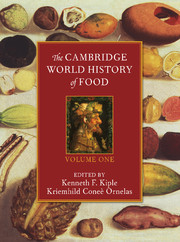Book contents
- Frontmatter
- Introduction
- Part I Determining What Our Ancestors Ate
- Part II Staple Foods: Domesticated Plants and Animals
- II.A Grains
- II.A.1 Amaranth
- II.A.2 Barley
- II.A.3 Buckwheat
- II.A.4 Maize
- II.A.5 Millets
- II.A.6 Oat
- II.A.7 Rice
- II.A.8 Rye
- II.A.9 Sorghum
- II.A.10 Wheat
- II.B Roots, Tubers, and Other Starchy Staples
- II.C Important Vegetable Supplements
- II.D Staple Nuts
- II.E Animal, Marine, and Vegetable Oils
- II.F Trading in Tastes
- II.G Important Foods from Animal Sources
- Part III Dietary Liquids
- Part IV The Nutrients – Deficiencies, Surfeits, and Food-Related Disorders
- References
II.A.9 - Sorghum
from II.A - Grains
Published online by Cambridge University Press: 28 March 2008
- Frontmatter
- Introduction
- Part I Determining What Our Ancestors Ate
- Part II Staple Foods: Domesticated Plants and Animals
- II.A Grains
- II.A.1 Amaranth
- II.A.2 Barley
- II.A.3 Buckwheat
- II.A.4 Maize
- II.A.5 Millets
- II.A.6 Oat
- II.A.7 Rice
- II.A.8 Rye
- II.A.9 Sorghum
- II.A.10 Wheat
- II.B Roots, Tubers, and Other Starchy Staples
- II.C Important Vegetable Supplements
- II.D Staple Nuts
- II.E Animal, Marine, and Vegetable Oils
- II.F Trading in Tastes
- II.G Important Foods from Animal Sources
- Part III Dietary Liquids
- Part IV The Nutrients – Deficiencies, Surfeits, and Food-Related Disorders
- References
Summary
Grain sorghum (Sorghum bicolor [Linn.]Moench) is a native African cereal now also widely grown in India, China, and the Americas. Sorghum ranks fifth in world cereal grain production, and fourth in value (after rice, wheat, and maize) as a cereal crop. It is grown on 40 to 50 million hectares annually, from which up to 60 million metric tons of grain are harvested. In Africa and Asia traditional cultivars are grown, usually with low agricultural inputs, and average yields are below 1 metric ton per hectare. But more than 3 metric tons of grain are harvested per acre in the Americas, where farmers plant modern sorghum hybrids. Sorghum is more tolerant to drought and better adapted for cultivation on saline soils than is maize. It holds tremendous promise as a cereal to feed the rapidly expanding populations of Africa and Asia. In the Americas it is replacing maize as an animal feed.
Morphology and Distribution
The grass genus Sorghum Moench is one of immense morphological variation. It is taxonomically subdivided into sections Chaetosorghum, Heterosorghum, Parasorghum, Stiposorghum, and Sorghum (Garber 1950), and these sections are recognized as separate genera by W. D. Clayton (1972). The genus Sorghum is here recognized to include: (1) a complex of tetraploid (2n = 40) rhizomatous taxa (S. halapense [Linn.]Pers.) that are widely distributed in the Mediterranean region and extend into tropical India; (2) a rhizomatous diploid (2n = 20) species (S. propinquum [Kunth]Hitchc.) that is distributed in Southeast Asia and extends into adjacent Pacific Islands; and (3) a nonrhizomatous tropical African diploid (2n = 20) complex (S. bicolor [Linn.]Moench) that includes domesticated grain sorghums and their closest wild and weedy relatives (de Wet and Harlan 1972). Genetic introgression is common where wild rhizomatous or spontaneous nonrhizomatous taxa become sympatric with grain sorghums, and derivatives of such introgression have become widely distributed as weeds in sorghum-growing regions.
- Type
- Chapter
- Information
- The Cambridge World History of Food , pp. 152 - 158Publisher: Cambridge University PressPrint publication year: 2000
References
- 1
- Cited by

